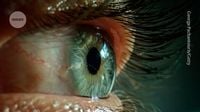In a groundbreaking study, researchers at the University of California, Berkeley, have enabled human subjects to perceive a color never before seen, dubbed "olo." This hue, described as a highly saturated blue-green, was made visible using a novel technique called "Oz," which involves precise laser stimulation of specific retinal cells.
The study, published in the journal Science Advances on April 18, 2025, marks a significant advancement in our understanding of human color perception. Traditionally, humans perceive color through specialized photoreceptive cells in the retina known as cones, which are classified into three types: short-wavelength (S) cones, medium-wavelength (M) cones, and long-wavelength (L) cones. These cones work together to interpret the light wavelengths that enter the eye, but they also have overlapping responses that limit the range of colors we can see.
In the study, the researchers used the Oz system to stimulate individual M cone cells with safe microdoses of laser light. By applying these doses in a precise spatial pattern, they successfully created the perception of a brand new color. Five volunteers with normal vision participated in the experiment, and upon activation of their M cones, they reported seeing a blue-green color of "unprecedented saturation." Ren Ng, a computer scientist and vision researcher involved in the study, described the color as something akin to a peacock blue or teal, but emphasized that its intensity is off the charts.
To verify that olo is indeed a new color, the researchers conducted color matching tests with the participants. One test involved using a near-monochromatic laser, which produces the most saturated colors visible in natural conditions. Participants could only match olo to this blue-green hue by reducing its saturation, confirming that olo lies outside the boundaries of normal human color vision.
According to Ng, the technique has the potential to create other new colors and could also help individuals with color blindness perceive hues they cannot normally see. However, the current setup of the Oz system allows for careful control of color in only a small area of vision, roughly twice the diameter that the Moon appears to cover in the sky.
Co-first author James Fong explained that the ultimate goal of their research is to provide programmable control over every photoreceptor in the retina. This level of control could open up new avenues for studying vision, including simulating the effects of eye diseases to better understand vision loss. Fong noted that while the current method is impressive, it still has limitations; for instance, participants cannot look directly at the Oz display due to the size of the cones in the center of the retina.
Despite the excitement surrounding the discovery of olo, some experts have raised questions about the validity of the claim. John Barbur, a vision scientist at City, St George's, University of London, argued that olo is not a new color but rather a more saturated green that can only be produced when M cones are stimulated in isolation. He stated, "It’s a more saturated green that can only be produced in a subject with normal red-green chromatic mechanism when the only input comes from M cones." Barbur suggested that the work has limited value.
Nonetheless, the researchers believe that the Oz technique could have broader applications beyond color perception. For instance, it may aid in understanding color blindness or diseases like retinitis pigmentosa, which affect vision. Ng remarked that while the research is foundational, the general public is unlikely to experience olo on smartphone displays or televisions anytime soon. "This is basic science," he explained. "We’re not going to see olo on any smartphone displays or any TVs any time soon. And this is very, very far beyond VR headset technology."
As the scientific community continues to explore the implications of this research, the discovery of olo has opened up new discussions about the nature of color perception and the potential for technological advancements in visual science. The team at Berkeley is hopeful that their findings will pave the way for future innovations in the field.









